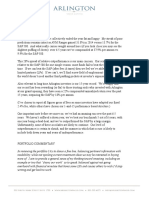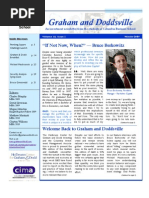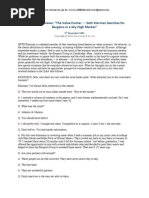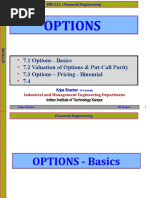Burry Scion1q2001
Burry Scion1q2001
Uploaded by
frankal1016147Copyright:
Available Formats
Burry Scion1q2001
Burry Scion1q2001
Uploaded by
frankal1016147Copyright
Available Formats
Share this document
Did you find this document useful?
Is this content inappropriate?
Copyright:
Available Formats
Burry Scion1q2001
Burry Scion1q2001
Uploaded by
frankal1016147Copyright:
Available Formats
Scion Value Fund, A Series of Scion Funds, LLC
6398 Purple Hills Drive San Jose, CA 95119 Phone (408) 363-1313 Fax (408) 363-1380
April 3, 2001 Dear Fellow Members: During the first quarter of 2001, the Scion Value Fund (Fund) appreciated 7.81% after deducting accrued and actual expenses and fees. The S&P 500 Index experienced a net loss of 12.21% during the period. Since its inception, the Fund has appreciated 14.96% net of fees and expenses, while the S&P 500 Index has recorded a loss of 18.82% during the same time period. As a result, since inception five months ago, the Fund has outperformed the S&P 500 by 3,379 basis points, or 33.79 percentage points. This performance was not without volatility. However, allow me to be quite stern on this subject: volatility does not determine risk. I guide the Fund to a net long position by investing in a concentrated manner and by frequently taking relatively illiquid positions in undervalued situations. The goal here is long-term capital appreciation, with the emphasis on long-term. Therefore, while the Fund may yield surprising results over short time frames, this phenomenon neither concerns me when the results seem cause for lament nor lifts me when the results seem cause for celebration. I urge the same reactions in you. Thus, I will advise that whatever numbers you see before you on your capital account statements, they should not be compounded into the future indefinitely. I fully expect and recommend that members of this investment vehicle judge my performance over a period of five years or greater, not five months or less. This will prove to be the most fruitful and enjoyable manner in which to participate in the Fund. Tax Policy One facet of my style and my investment manner is extremely well suited to finding and profiting from tax-loss losers during November and December and riding them through January. In the past, this has been a successful activity, and I have occasionally found some longer-term holds within the group. Never have I had the success I had this past January, however, and I did not react well to it in context. Heres the context. Tax loss selling takes many poorly performing stocks to even more extreme lows nearly every year during the late fall. Mutual funds must realize such losses by October 31st and others have until December 31st. However, in many cases these stocks represent businesses under significant duress. Aside from a moderate January bump as selling pressure is alleviated and as stockholders once again buy into these stocks, one would not expect such despised stocks to truly reflect, in short-run, any realization of longer-term or
hidden value. With the clarity of hindsight, I see now that my stocks bought amidst the vicious sell-off of mid-December were no match for the vicious sell-off of mid-March. While nearly all remained above the purchase price, the amount of short-term profits given back to the market this quarter remains wholly unsatisfactory. Most unsatisfactory results are not without reason, and this one is no exception. I failed to clearly re-establish the tax policy of the Fund after it was subtly suggested that paying taxes was something to avoid. Although this thought was far from startling, I allowed it to persuade me to hold on to a few extremely profitable positions too long. This feeling is not uncommon in the market today, but I did know better, and I did break with a long-standing tax policy that has contributed significantly to my success as a portfolio manager. In order to ensure we do not have a repeat, allow me to clarify the Funds position on taxes. I am a tax-paying US citizen, and hence I am in the same boat as many, but not all, of you. I also have more of my net worth in the Fund than any other member, and in dollar terms it is the largest as well. However, I will not let the prospect of taxes on gains prevent the achievement of those gains. To recap, January saw a rapid run-up in the value of your investment in the Fund. One competitive advantage of mine has been taking advantage of the fast times to raise cash for the next slow time, to rotate into less-appreciated securities, and occasionally to short into speculative excess. This can result in my investment strategy producing higher profit, higher turnover, and, yes, higher taxes. In the past, it has done so. In the future, I expect it to do so. For now, I must simply point to one opportunity sorely missed, to one achievement not yet accomplished on your behalf, and to taxes, unfortunately, drastically reduced. Market Overview 1Q 2001 When I stand on my special-issue Intelligent Investor ladder and peer out over the frenzied crowd, I see very few others doing the same. Many stocks remain overvalued, and speculative excess both on the upside and on the downside - is embedded in the frenzy around stocks of all stripes. And yes, I am talking about March 2001, not March 2000. In essence, the stock market represents three separate categories of business. They are, adjusted for inflation, those with shrinking intrinsic value, those with approximately stable intrinsic value, and those with steadily growing intrinsic value. The preference, always, would be to buy a long-term franchise at a substantial discount from growing intrinsic value. However, if one has been playing the buy-and-hold game with quality securities, one has been exposed to a substantial amount of market risk because the valuations placed on these securities have implied overly rosy scenarios prone to popular revision in times of more realistic expectation. This is one of those times, but it is my feeling that the revisions have not been severe enough, the expectations not yet realistic enough. Hence, the worlds best companies largely remain overpriced in the marketplace. The bulk of the opportunities remain in undervalued, smaller, more illiquid situations that often represent average or slightly above-average businesses these stocks, having largely missed out on the speculative ride up, have nevertheless frequently been pushed down to absurd levels owing to their illiquidity during a general market panic. I will not label this 2
Fund a small cap fund, for this may not be where the best opportunities are next month or next year. For now, though, the Fund is biased toward smaller capitalization stocks. As for the future, I can only say the Fund will always be biased to where the value is. If recent trends continue, it would not be surprising to find the stocks of several larger capitalization stocks with significant long-term franchises meet value criteria and hence become eligible for potential addition to the Fund. Where the Value Isnt With many large cap technology sector stocks falling out of favor, one might be tempted to jump into the fray and find a bottom. This is all well and good, but there is a flaw at the first assumption here. All stocks, including technology stocks, must find a floor in terms of fundamental value and expected return to the stockholder before they find an era-defining floor in price. In most all cases, the floor will be much lower than popular opinion might indicate and much lower than fair value. Investors ought to take care to be coldly realistic in their appraisals. Following is an outline of a problem that a lot of technology-related companies face and that makes their stocks in general overvalued. Unlike nearly every other industry, technology companies, as they are generally grouped these days, compensate their employees in a manner that hides much of the expense of the compensation from the income statement. Of course, the subject here is options compensation. With the most prevalent type of option - called nonqualified stock options - the difference between the price of the stock and the price of the options when exercised accrues to the employee as income that must be taxed because it is considered compensation. Not according to GAAP (Generally Accepted Accounting Principles), but according to the Internal Revenue Service (IRS). So the IRS gives companies a break and allows them, for tax purposes, to deduct this options expense that employees receive as income. The net result is an income tax benefit to the company of roughly 35% of the sum total difference between the exercise price of the companys nonqualified options during a given year and the market price of the stock at the time of exercise. Since GAAP does not recognize this in the income statement, the cash flow statements record this Tax benefit from exercise of stock options as a positive adjustment to net income. After all, the company included neither the cost of the options nor the income tax benefit on the profit/loss statement. Hence, the correction to cash flow. So cash income is understated by net income, right? Wrong. When evaluating US companies, conservative investors ought to assume that if the IRS can tax something, then it is a real profit. And if they allow one to deduct something, then it is a real cost. In a rising market, the net income tax benefit can be quite large but it only reflects roughly 35% of the actual cost of paying employees with options. How does it cost the company? Because the company must either issue new stock at a severe discount to prevailing market prices or buy back stock at prevailing market prices in order to provide stock at a discount for employees exercising their options. The cost is borne by shareholders, who suffer from
significant dilution. The per share numbers worsen, while the absolute numbers improve. After all, issuing stock at any price is a positive event for cash flow if not for shareholders. Adobe Systems, for instance, is widely regarded as a good company with a decent franchise. A bit cyclical maybe, but a member of the Nasdaq 100 and the S&P 500. It is widely held by institutions. Looking at its annual report for 2000, one sees that the income tax benefit for options supplied $125 million, or roughly 28% of operating cash flow. Fair enough. Lets move to the income statement. Divide that $125 million by a corporate tax rate of around 35%, and one gets an amount of $357 million. Thats the amount of employee compensation that the IRS recognizes Adobe paid in the form of options, but that does not appear on the income statement. Plugging it into the income statement as an expense drops the operating income less investment gains and interest from $408 million to $51 million. Tax that and you get net income somewhere around $33 million and an abnormally small tax payment to the IRS. That $33 million is a good proxy for the amount of net income that public shareholders get after the companys senior management and employees feed at the trough. For this $33 million roughly 1/10 of the reported earnings - shareholders were paying $8.7 billion around the time of this writing. Shareholders of such firms as Seibel Systems, Oracle and Xilinx were paying near infinite multiples on last years earnings, as a similar exercise shows that these firms paid employees more money in options compensation than their entire net income last year. Many, and probably most, technology companies are therefore private companies in the public domain existing for themselves, not for their shareholder owners. Of course, it is a shell game. A prolonged depressed stock price for whatever reason, including a bear market would cause a lot of options to become worthless, and would likely require the company to either start paying more in salary or, often worse, to start re-pricing options at lower prices. Even if neither action is taken, operating cash flow takes a hit. In truth, this type of activity might be expected from companies that were often created with the help of venture capitalists who viewed public shareholders as an exit strategy, not as a group that deserves to benefit from improving company results and prospects. The significant implication here is that shareholders cannot count on these sorts of companies for proper corporate governance. They have demonstrated that they will ask shareholders to bear the burden during good times and that they will re-price options during bad times, thereby taking from shareholders both on the way up and on the way down. Such an argument has very significant implications for the valuation of many popular stocks. In a coldly calculating market rather than a speculative one, the stocks of companies governed with so little respect for shareholders will suffer. It is not limited to Adobe, Seibel, or Xilinx. Cisco, Intel, Microsoft and many of the greatest technology-related wealth creators of the last decade are in the same boat. Now that the bubble is burst, it is not my expectation that we will see any lasting rebound in the stocks of companies in the hands of such reckless management teams. Indeed, it is quite certain that public expectations regarding these companies stocks will not be met. 4
Volatility Revisited Because expenses are relatively fixed, higher amounts of assets dilute the expense ratio. Therefore, in keeping with the goal to lower the expense ratio, efforts must be made on occasion to raise new capital. While attempting to raise new capital recently, your manager has recently had a colorful experience that is fairly illuminating with regards to the hallowed ground on which most investors consider volatility. I delivered a short talk at the Banc of America Alternative Investment Strategies Symposium in Los Angeles last month. I had a good slot immediately after the keynote speaker and at about 9 oclock in the a.m. A room of about 200 wealthy potential clients heard me state unequivocally that risk is not defined by volatility, but rather by ill-conceived investment. The corollaries, as I pointed out, were that portfolio concentration and illiquidity do not define risk. That simple statement, I am told, had not just a few of those in the room shaking their heads. The very pleasant gentleman who spoke after me then proceeded to delineate how frequently his portfolio moved with a magnitude greater than 1% on a daily basis. I think the number was quite impressive for an institution that measures itself by such things somewhere around 25 days in the past two years or so. And this, he proclaimed, minimized volatility and thus risk. He seemed a decent fellow, and if you wish me to provide his name and number, I would be happy to do so. Not that he necessarily needs the business. Perhaps it is not so surprising that your portfolio manager sat relatively alone at his lunch table, while the second fellow was quite popular. By and large, the wealthiest of the wealthy and their representatives have accepted that most managers are average, and the better ones are able to achieve average returns while exhibiting below-average volatility. By this logic, however, a dollar selling for 50 cents one day, 60 cents the next day, and 40 cents the next somehow becomes worth less than a dollar selling for 50 cents all three days. I would argue that the ability to buy at 40 cents presents opportunity, not risk, and that the dollar is still worth a dollar. The stock market is full of dollars selling for much more than a dollar. A dollar that consistently sells at 1.1X face value may even be respected for the consistency of this quality, earning it the right to have that premium. These are not the investments your portfolio manager chooses for the Fund. A wildly fluctuating dollar selling for 40 or 50 or 60 cents will always remain more attractive and far less risky. As for my loneliness at the lunch table, it has always been a maxim of mine that while capital raising may be a popularity contest, intelligent investment is quite the opposite. One must therefore take some pride in such a universal lack of appeal.
Policy Matters While I will continue to attempt to raise new capital, it will not be my policy to compromise the Funds current policies to do so. You have all accepted the Fund on its own terms, and first and foremost it is my intention to protect your capital and enhance your returns. Be assured that I eat my own cooking. The vast majority of my net worth, aside from money set aside for modest living expenses, is in the Fund. If I compound my own investment in the Fund at a rate of 20% annually, excluding fees, for 30 years, I will have over $250 million. If I can do 25%, I will have nearly $1 billion. This is how I think about your investment. It is also why I do not think in terms of monthly or quarterly snapshots of performance, although I do understand that after five years or so you would expect to see a favorable trend. I intend to provide it. To this end, I will change the schedule of new investment to a quarterly basis. May 1st will be the last start date on which new investment in the Fund may be initiated on the monthly schedule. From then on, the Fund will accept new investors on the first of July, the first of October, the first of January, the first of April, and so forth. I will retain the right to allow investments at other times, but only as a rare exception in the face of overwhelming justification. Members may continue to add to their holdings on a monthly basis. Also, the minimum initial investment in the Fund for future investors will be raised to $250,000 as of the July 1, 2001 investment date. Current members and those with planned investment during April for a May 1 start are exempt from this new minimum. Please feel free to call me if I have not been clear, or if you need further clarification on a matter discussed above. Sincerely, Michael J. Burry Scion Capital, LLC
You might also like
- KEY - Resources - Roadmap3 - Quant Algo Trading Systems Coding Tradingview $SPX $NQ - F $ES - F Start HereDocument21 pagesKEY - Resources - Roadmap3 - Quant Algo Trading Systems Coding Tradingview $SPX $NQ - F $ES - F Start HereNatalia100% (1)
- 7.7 Shopee Mall Great Sale 2022 Pitch DeckDocument68 pages7.7 Shopee Mall Great Sale 2022 Pitch DeckIhaw Halim100% (1)
- Sample Option ContractDocument9 pagesSample Option ContractChris Ce100% (1)
- Oi Pulse Manual FileDocument297 pagesOi Pulse Manual FilePraveen C75% (4)
- Lisa Rapuano Finding Your Way Along The Many Paths of ValueDocument29 pagesLisa Rapuano Finding Your Way Along The Many Paths of ValueValueWalk100% (2)
- 2009 Annual LetterDocument5 pages2009 Annual Letterppate100% (1)
- Josh-Tarasoff Markel InsuranceDocument25 pagesJosh-Tarasoff Markel InsuranceCanadianValue50% (2)
- David Tepper S 2007 Presentation at Carnegie Mellon PDFDocument7 pagesDavid Tepper S 2007 Presentation at Carnegie Mellon PDFPattyPattersonNo ratings yet
- Geico Case Study PDFDocument22 pagesGeico Case Study PDFMichael Cano LombardoNo ratings yet
- Forex Brokerage Firm Business PlanDocument13 pagesForex Brokerage Firm Business PlanmubitaNo ratings yet
- Option Purchase Agreement - EngDocument7 pagesOption Purchase Agreement - Engmasterfox50% (2)
- The Art & Science Of Preferred Dividend InvestingFrom EverandThe Art & Science Of Preferred Dividend InvestingRating: 4 out of 5 stars4/5 (1)
- Graham and Doddsville - Issue 9 - Spring 2010Document33 pagesGraham and Doddsville - Issue 9 - Spring 2010g4nz0No ratings yet
- Schloss-10 11 06Document3 pagesSchloss-10 11 06Logic Gate CapitalNo ratings yet
- Arlington Value 2014 Annual Letter PDFDocument8 pagesArlington Value 2014 Annual Letter PDFChrisNo ratings yet
- DanLoeb BloombergDocument9 pagesDanLoeb BloombergbillcaneNo ratings yet
- 2012 Commencement Speech Michael BurryDocument5 pages2012 Commencement Speech Michael BurryJorge PerezNo ratings yet
- Bruce Greenwald - IBBDocument18 pagesBruce Greenwald - IBBvivekNo ratings yet
- Walter SchlossDocument2 pagesWalter SchlossLogic Gate Capital100% (2)
- Schloss 1965Document2 pagesSchloss 1965Logic Gate CapitalNo ratings yet
- Teledyne and Henry Singleton A CS of A Great Capital AllocatorDocument34 pagesTeledyne and Henry Singleton A CS of A Great Capital Allocatorp_rishi_2000No ratings yet
- Michael Price Lecture Notes - 1292015Document4 pagesMichael Price Lecture Notes - 1292015brett_gardner_3No ratings yet
- High Conviction Barrons Talks With RiverParkWedgewood Fund Portfolio Manager David RolfeDocument3 pagesHigh Conviction Barrons Talks With RiverParkWedgewood Fund Portfolio Manager David RolfebernhardfNo ratings yet
- Notes From Jim Chanos' Presentation at The CFA Institute's Annual ConferenceDocument3 pagesNotes From Jim Chanos' Presentation at The CFA Institute's Annual ConferenceCameron Wright100% (1)
- Brian Spector Leaving Baupost Letter - Business InsiderDocument4 pagesBrian Spector Leaving Baupost Letter - Business InsiderHedge Fund ConversationsNo ratings yet
- VIIWordsofWisdom PDFDocument43 pagesVIIWordsofWisdom PDFRajeev BahugunaNo ratings yet
- A Legacy: The Sons of StanfordDocument12 pagesA Legacy: The Sons of StanfordMeiNo ratings yet
- Burry WriteupsDocument15 pagesBurry WriteupseclecticvalueNo ratings yet
- 1976 Buffett Letter About Geico - FutureBlindDocument4 pages1976 Buffett Letter About Geico - FutureBlindPradeep RaghunathanNo ratings yet
- When Entry Multiples Don't Matter - Andreessen Horowitz PDFDocument12 pagesWhen Entry Multiples Don't Matter - Andreessen Horowitz PDFbrineshrimpNo ratings yet
- 0313 ChuckAkre TranscriptDocument9 pages0313 ChuckAkre TranscriptKrishnan SubrahmanyamNo ratings yet
- Nick Train The King of Buy and HoldDocument13 pagesNick Train The King of Buy and HoldkessbrokerNo ratings yet
- Redleaf Andy Absolute Return WhiteboxDocument6 pagesRedleaf Andy Absolute Return WhiteboxMatt Taylor100% (1)
- Olesen Value Fund L.P. Q1 2014 Investor LetterDocument5 pagesOlesen Value Fund L.P. Q1 2014 Investor LetterValueWalk100% (1)
- Glenn Greenberg at ColumbiaDocument2 pagesGlenn Greenberg at ColumbiaJUDS1234567No ratings yet
- Seth Klarman's Baupost Fund Semi-Annual Report 19991Document24 pagesSeth Klarman's Baupost Fund Semi-Annual Report 19991nabsNo ratings yet
- Value Investors Club - AMAZONDocument11 pagesValue Investors Club - AMAZONMichael Lee100% (1)
- 1 Robert Robotti Presentation 2013 Ben Graham Centre Value Investing ConferenceDocument41 pages1 Robert Robotti Presentation 2013 Ben Graham Centre Value Investing ConferenceLuiz SobrinhoNo ratings yet
- Vanderbilt Chancellor Talk April 5 2011 BurryDocument10 pagesVanderbilt Chancellor Talk April 5 2011 Burrymchallis100% (1)
- Walter Schloss List of StocksDocument7 pagesWalter Schloss List of StocksDistressedDebtInvestNo ratings yet
- Seth Klarman Views (24 PGS) June 2013Document24 pagesSeth Klarman Views (24 PGS) June 2013kumarp13No ratings yet
- Klarman Yield PigDocument2 pagesKlarman Yield Pigalexg6No ratings yet
- Contrarian Value Bill Miller's Investment Approach Ben HobsonDocument3 pagesContrarian Value Bill Miller's Investment Approach Ben Hobsonkljlkhy9No ratings yet
- Graham & Doddsville - Issue 15 - Spring 2012Document64 pagesGraham & Doddsville - Issue 15 - Spring 2012Filipe DurandNo ratings yet
- Profiles in Investing - Marty Whitman (Bottom Line 2004)Document1 pageProfiles in Investing - Marty Whitman (Bottom Line 2004)tatsrus1No ratings yet
- BruceGreenwald InterviewDocument5 pagesBruceGreenwald Interviewekramcal100% (2)
- Alice Schroeder Warren Buffett.Document21 pagesAlice Schroeder Warren Buffett.Ahmad Damasanto100% (1)
- Berkshire NFM LetterDocument4 pagesBerkshire NFM Letterjkusnan3341No ratings yet
- Third Point Q2 16Document11 pagesThird Point Q2 16marketfolly.com100% (1)
- Klarman CBS PDFDocument3 pagesKlarman CBS PDFbillroberts981100% (1)
- RV Capital June 2015 LetterDocument8 pagesRV Capital June 2015 LetterCanadianValueNo ratings yet
- The 400% Man: How A College Dropout at A Tiny Utah Fund Beat Wall Street, and Why Most Managers Are Scared To Copy HimDocument5 pagesThe 400% Man: How A College Dropout at A Tiny Utah Fund Beat Wall Street, and Why Most Managers Are Scared To Copy Himrakeshmoney99No ratings yet
- ThirdPoint Q1 16Document9 pagesThirdPoint Q1 16marketfolly.comNo ratings yet
- SuperInvestorInsight Issue 20Document10 pagesSuperInvestorInsight Issue 20johanschNo ratings yet
- Prem Watsa - The 2 Billion Dollar Man - Toronto Live - 04-2009Document6 pagesPrem Watsa - The 2 Billion Dollar Man - Toronto Live - 04-2009Damon MengNo ratings yet
- Bruce BerkowitzDocument35 pagesBruce Berkowitznewbietrader100% (1)
- Barrons Roundtable Jan 1968 Part IDocument5 pagesBarrons Roundtable Jan 1968 Part Ijkusnan3341No ratings yet
- Seth Klarman 1991 InterviewDocument17 pagesSeth Klarman 1991 InterviewCanadianValue100% (1)
- Financial Fine Print: Uncovering a Company's True ValueFrom EverandFinancial Fine Print: Uncovering a Company's True ValueRating: 3 out of 5 stars3/5 (3)
- Economist on Wall Street (Peter L. Bernstein's Finance Classics): Notes on the Sanctity of Gold, the Value of Money, the Security of Investments, and Other DelusionsFrom EverandEconomist on Wall Street (Peter L. Bernstein's Finance Classics): Notes on the Sanctity of Gold, the Value of Money, the Security of Investments, and Other DelusionsNo ratings yet
- Summary of Heather Brilliant & Elizabeth Collins's Why Moats MatterFrom EverandSummary of Heather Brilliant & Elizabeth Collins's Why Moats MatterNo ratings yet
- Measurement of Share OptionsDocument2 pagesMeasurement of Share OptionsAngela MacailaoNo ratings yet
- Eun 9e International Financial Management PPT CH08 Accessible 1Document36 pagesEun 9e International Financial Management PPT CH08 Accessible 1MS Fin.No ratings yet
- Questionnaire For Investors363Document4 pagesQuestionnaire For Investors363Giridhari B ChandrabansiNo ratings yet
- Fsa 9QDocument23 pagesFsa 9Qpriyanshu.goel1710No ratings yet
- How Can One Become A Successful Option ScalperDocument18 pagesHow Can One Become A Successful Option ScalperlambazNo ratings yet
- ACCT6003 FAP Assessment Brief Part BDocument5 pagesACCT6003 FAP Assessment Brief Part BCrystal Welch0% (1)
- Path Integrals LinetskyDocument35 pagesPath Integrals LinetskyStephen GoodmanNo ratings yet
- Risk - Unit 3 (B)Document23 pagesRisk - Unit 3 (B)Asan BilalNo ratings yet
- Last Minute Tips Civil Law 2017 Atty. Buko Dela CruzDocument26 pagesLast Minute Tips Civil Law 2017 Atty. Buko Dela Cruzrobertoii_suarezNo ratings yet
- SimulationPerformance 15.2 en r1596 PDFDocument25 pagesSimulationPerformance 15.2 en r1596 PDFJennifer CharlesNo ratings yet
- Far 7 Flashcards - QuizletDocument31 pagesFar 7 Flashcards - QuizletnikoladjonajNo ratings yet
- Ba 322 PPT Chapter 2Document9 pagesBa 322 PPT Chapter 2akanshavermaNo ratings yet
- 7.3 Options - Pricing Binomial-1Document25 pages7.3 Options - Pricing Binomial-1Siva SankarNo ratings yet
- XA Risk Reward RatioDocument4 pagesXA Risk Reward Ratiocarlos.ernesto.aa2023No ratings yet
- Soal Pilihan Ganda Pak BudyDocument6 pagesSoal Pilihan Ganda Pak BudyMolly WoodsNo ratings yet
- Accounting Business Law FinanceDocument8 pagesAccounting Business Law FinanceromeeNo ratings yet
- Trading For A LivingDocument10 pagesTrading For A Livingwerner ongNo ratings yet
- CFO-Forum EEV Principles and Guidance April 2016Document22 pagesCFO-Forum EEV Principles and Guidance April 2016apluNo ratings yet
- Spartina Convertible Note MemoDocument6 pagesSpartina Convertible Note MemospartinaNo ratings yet
- Assignment 3Document2 pagesAssignment 3ipm01bachalasNo ratings yet
- Basics of Stock Market For BeginnersDocument58 pagesBasics of Stock Market For BeginnersYatharth DassNo ratings yet
- AS - SAMPLE FINAL EXAM PAPER - FIN700 - Finl MGT - T318Document20 pagesAS - SAMPLE FINAL EXAM PAPER - FIN700 - Finl MGT - T318Mahbub Zaman Ashrafi100% (1)
- Chapter 13Document44 pagesChapter 13Amylia AmirNo ratings yet
- Commission General Fee ScheduleDocument12 pagesCommission General Fee ScheduleKaren Jennifer WkcNo ratings yet

























































































